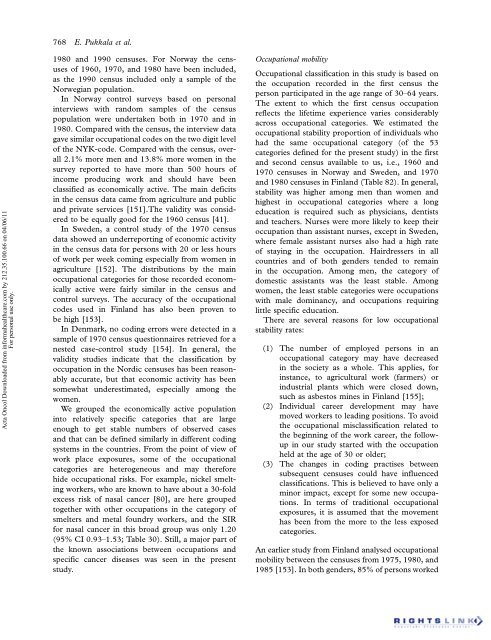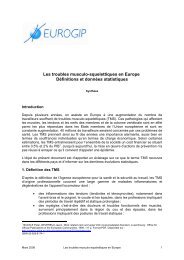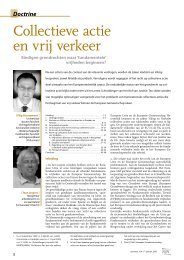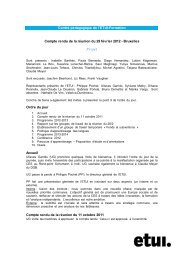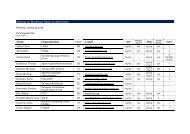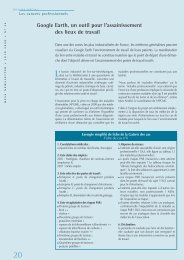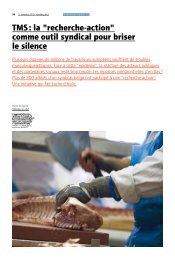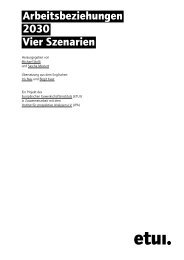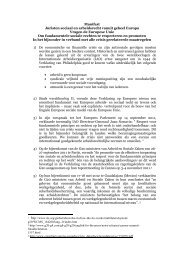Occupation and cancer - European Trade Union Institute (ETUI)
Occupation and cancer - European Trade Union Institute (ETUI)
Occupation and cancer - European Trade Union Institute (ETUI)
You also want an ePaper? Increase the reach of your titles
YUMPU automatically turns print PDFs into web optimized ePapers that Google loves.
Acta Oncol Downloaded from informahealthcare.com by 212.35.100.66 on 04/06/11<br />
For personal use only.<br />
768 E. Pukkala et al.<br />
1980 <strong>and</strong> 1990 censuses. For Norway the censuses<br />
of 1960, 1970, <strong>and</strong> 1980 have been included,<br />
as the 1990 census included only a sample of the<br />
Norwegian population.<br />
In Norway control surveys based on personal<br />
interviews with r<strong>and</strong>om samples of the census<br />
population were undertaken both in 1970 <strong>and</strong> in<br />
1980. Compared with the census, the interview data<br />
gave similar occupational codes on the two digit level<br />
of the NYK-code. Compared with the census, overall<br />
2.1% more men <strong>and</strong> 13.8% more women in the<br />
survey reported to have more than 500 hours of<br />
income producing work <strong>and</strong> should have been<br />
classified as economically active. The main deficits<br />
in the census data came from agriculture <strong>and</strong> public<br />
<strong>and</strong> private services [151].The validity was considered<br />
to be equally good for the 1960 census [41].<br />
In Sweden, a control study of the 1970 census<br />
data showed an underreporting of economic activity<br />
in the census data for persons with 20 or less hours<br />
of work per week coming especially from women in<br />
agriculture [152]. The distributions by the main<br />
occupational categories for those recorded economically<br />
active were fairly similar in the census <strong>and</strong><br />
control surveys. The accuracy of the occupational<br />
codes used in Finl<strong>and</strong> has also been proven to<br />
be high [153].<br />
In Denmark, no coding errors were detected in a<br />
sample of 1970 census questionnaires retrieved for a<br />
nested case-control study [154]. In general, the<br />
validity studies indicate that the classification by<br />
occupation in the Nordic censuses has been reasonably<br />
accurate, but that economic activity has been<br />
somewhat underestimated, especially among the<br />
women.<br />
We grouped the economically active population<br />
into relatively specific categories that are large<br />
enough to get stable numbers of observed cases<br />
<strong>and</strong> that can be defined similarly in different coding<br />
systems in the countries. From the point of view of<br />
work place exposures, some of the occupational<br />
categories are heterogeneous <strong>and</strong> may therefore<br />
hide occupational risks. For example, nickel smelting<br />
workers, who are known to have about a 30-fold<br />
excess risk of nasal <strong>cancer</strong> [80], are here grouped<br />
together with other occupations in the category of<br />
smelters <strong>and</strong> metal foundry workers, <strong>and</strong> the SIR<br />
for nasal <strong>cancer</strong> in this broad group was only 1.20<br />
(95% CI 0.93 1.53; Table 30). Still, a major part of<br />
the known associations between occupations <strong>and</strong><br />
specific <strong>cancer</strong> diseases was seen in the present<br />
study.<br />
<strong>Occupation</strong>al mobility<br />
<strong>Occupation</strong>al classification in this study is based on<br />
the occupation recorded in the first census the<br />
person participated in the age range of 30 64 years.<br />
The extent to which the first census occupation<br />
reflects the lifetime experience varies considerably<br />
across occupational categories. We estimated the<br />
occupational stability proportion of individuals who<br />
had the same occupational category (of the 53<br />
categories defined for the present study) in the first<br />
<strong>and</strong> second census available to us, i.e., 1960 <strong>and</strong><br />
1970 censuses in Norway <strong>and</strong> Sweden, <strong>and</strong> 1970<br />
<strong>and</strong> 1980 censuses in Finl<strong>and</strong> (Table 82). In general,<br />
stability was higher among men than women <strong>and</strong><br />
highest in occupational categories where a long<br />
education is required such as physicians, dentists<br />
<strong>and</strong> teachers. Nurses were more likely to keep their<br />
occupation than assistant nurses, except in Sweden,<br />
where female assistant nurses also had a high rate<br />
of staying in the occupation. Hairdressers in all<br />
countries <strong>and</strong> of both genders tended to remain<br />
in the occupation. Among men, the category of<br />
domestic assistants was the least stable. Among<br />
women, the least stable categories were occupations<br />
with male dominancy, <strong>and</strong> occupations requiring<br />
little specific education.<br />
There are several reasons for low occupational<br />
stability rates:<br />
(1) The number of employed persons in an<br />
occupational category may have decreased<br />
in the society as a whole. This applies, for<br />
instance, to agricultural work (farmers) or<br />
industrial plants which were closed down,<br />
such as asbestos mines in Finl<strong>and</strong> [155];<br />
(2) Individual career development may have<br />
moved workers to leading positions. To avoid<br />
the occupational misclassification related to<br />
the beginning of the work career, the followup<br />
in our study started with the occupation<br />
held at the age of 30 or older;<br />
(3) The changes in coding practises between<br />
subsequent censuses could have influenced<br />
classifications. This is believed to have only a<br />
minor impact, except for some new occupations.<br />
In terms of traditional occupational<br />
exposures, it is assumed that the movement<br />
has been from the more to the less exposed<br />
categories.<br />
An earlier study from Finl<strong>and</strong> analysed occupational<br />
mobility between the censuses from 1975, 1980, <strong>and</strong><br />
1985 [153]. In both genders, 85% of persons worked


